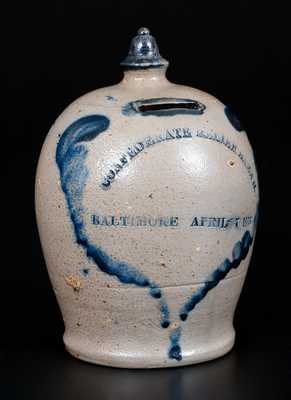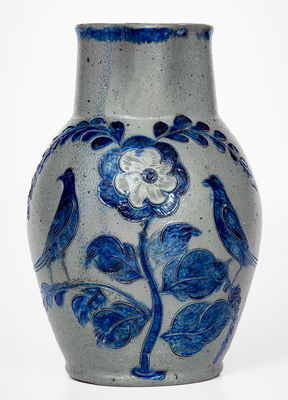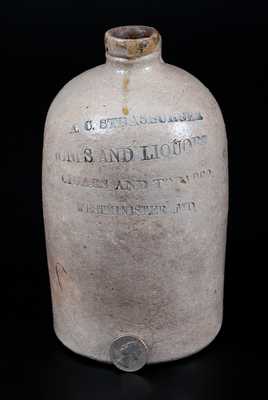Extremely Rare and Important Cobalt-Decorated Stoneware Bank with Civil War Reference, Inscribed "CONFEDERATE RELIEF BAZAR / BALTIMORE APRIL 7, 1885", Charles Hartung, Baltimore, MD, 1885, large-sized bank of beehive form with tooled shoulder, carved slot, and bell-shaped finial, the front featuring a brushed cobalt wreath surrounding the impressed inscription "CONFEDERATE RELIEF BAZAR, / BALTIMORE APRIL 7 1885". Cobalt highlights to inscription, carved slot, and finial. This historically-significant bank is one of two known examples made for this event. Confederate Relief bazaars were held during the late 19th and early 20th centuries at the Fifth Regiment Armory in Baltimore to raise funds for poverty-stricken Confederate veterans. The 1901 bazaar was described as follows in the papers of the Southern Historical Society, an organization founded by Confederate Major General, Daubney Maury: "The Daughters of the Confederacy in Maryland held a popular and successful bazaar in the Fifth Regiment armory, Baltimore, December 2d to 11th ultimo, which yielded about $10,000 for the fund to erect a monument in Baltimore city to the Marylanders in the Confederate service. The monument will cost, perhaps, $25,000. The heroism of the Maryland soldiers and sailors of the Confederate States is known and acknowledged by all intelligent and fair minded men and women in Maryland, as elsewhere. 'Young men and maidens, old men and children,' praise their valor and sacrifices for principle, and resound their deathless fame. All shades of religion and politics are represented by the contributors to the monument fund, even as when the two previous bazaars were held in the same place by the same noble women of Maryland in 1885 and 1893, to supply the means to provide for indigent and worthy Confederates in Maryland, who hail from all parts of the South, the proceeds of those two bazaars being collectively about $50,000. A Southern bazaar was first held in Baltimore under the auspices of the ladies, in April, 1866, one year after the war, which yielded over $200,000, for the relief of suffering Southern people. Within a year thereafter the Legislature of Maryland appropriated $100,000 for like purpose." (Southern Historical Society Papers, Richmond, VA, Vol. XXIX, 1901). The bank's maker, Charles Hartung, was born in 1844 in Bremen, Germany, and operated a stoneware manufactory at the corner of Frederick Road and Wilkens Street during the second half of the 19th century. An article in The Baltimore American (4/14/1885, p. 4, col. 3) states, "The pottery made expressly for the Bazar, with its stamp, by Charles Hartung, of the Frederick road, is all sold." Another article in The American (4/9/1885, p. 4, col.4-5) describes, "Almost every county in Maryland has sent some contribution to the state table. All the articles are selling well at a reasonable price. Just in the rear of the table is a manufactory of pottery, where jugs, vases, &c., are produced, with the stamp 'Confederate Relief Bazar' on the outside." This bank bears the distinction of being one of a very few American stoneware objects featuring an inscription referencing the Confederacy. Maryland's role as a border state was a complicated one during the Civil War, and this object testifies to the strong Southern sympathy still held by Marylanders in the decades that followed. It survives as a ceramic work of great historical significance to the state of Maryland and city of Baltimore. Section of finial professionally-restored. Otherwise excellent condition with a few faint surface lines, probably in-the-firing, and a dry, in-the-firing contact mark to reverse. H 8".















